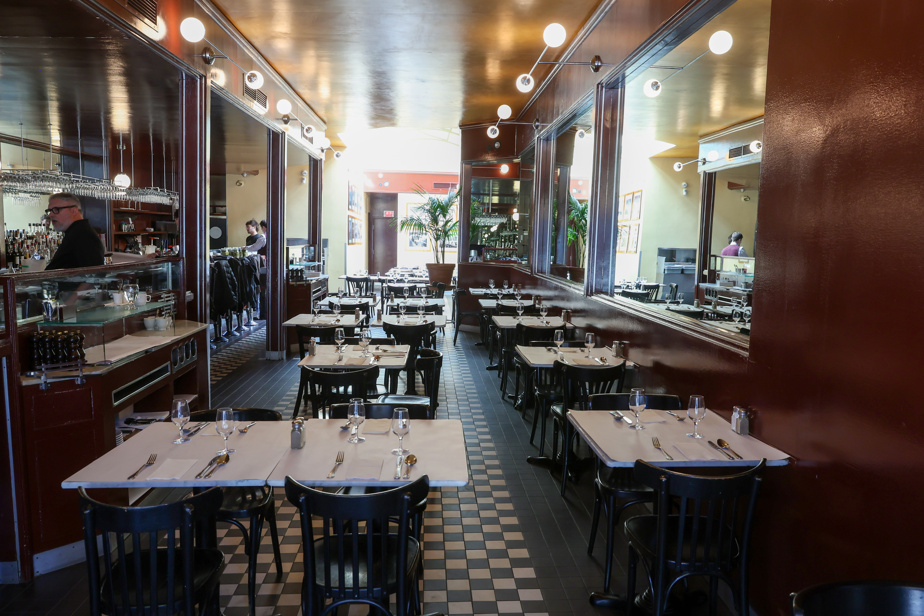L’Express served its first customers on December 19, 1980, targeting artists and other theater workers, as well as their spectators. François Tremblay, Colette Brossoit and Pierre Villeneuve were the founders. It’s often said that the team viewed their restaurant as a “public service”: “reliable, comforting, welcoming, no matter the hour,” the site writes.
And we know the rest. For years, the doors were open seven days, morning, noon, evening and even at night, not closing until 3 a.m. After COVID-19, breakfast did not resume. The restaurant has reopened five days a week, six recently, soon to be seven, if the workforce continues. “It’s starting to smell like Sundays!” “, confirms Mario Brossoit (brother of Colette, who died in 2014). The kitchen and dining room close an hour earlier than before. The fact remains that being able to order a salmon with chervil at half past midnight is a very rare thing in the metropolis.
It was in 2016 that Jean-François Vachon, a former Les Caprices de Nicolas, Club des Pins and M sur Masson, among others, took over the kitchen, replacing a retired Joël Chapoulie. The latter had given three decades of loyal service. Like many French chefs, he arrived in Montreal during Expo 67. Today, it is almost at the risk of his life that Mr. Vachon can make changes to the mythical menu developed by Mr. Chapoulie and offer new dishes! But so far, so good.
L’Express is now managed by Hélène Dansereau, Pierre Villeneuve and the indefatigable Mario Brossoit, who still contributes to the superb wine list of the place. Don’t look for the famous bartender Monsieur Masson. He served his last martini just before COVID-19 and is enjoying his well-deserved retirement.
L’Express is a source of joy for those who have been there for a long time. The faithful have their favorite dishes that the kitchen would be ill-advised to eliminate: sorrel soup, marrow bone, chicken liver mousse, tartare, veal liver, kidneys, etc.
For me, it goes back to childhood, when my mother and I made the occasional trip to Montreal from the federal capital where we lived. It was in the room with glossy walls and ceiling and mythical black and white grid, the work of the late architect Luc Laporte, that I discovered the hot goat cheese, celeriac-remoulade and small French pickles. We also ate ravioli and steak and fries. I learned about the existence of these delicious little birds called quail. In short, L’Express was one of my first culinary “schools”.
With the exception of the goat cheese, which today is wrapped in kataifi dough (those angel hairs with which we also make a dessert similar to baklava) rather than being placed on croutons, as I preferred ( nostalgia when you hold us!), my “madeleines de Proust” remained pretty much intact. The ravioli sauce is still deliciously sticky with collagen, so much has it been reduced. The golden quails rest as before on a bed of wild rice, with their little hard-cooked eggs.
My lover, who grew up with this cuisine even more than me, in France, took advantage of the excellent reputation of the house to order the kidneys. A “brown” dish if ever there was one, with its mushrooms, its melt-in-your-mouth roasted potato cubes and its rich mustard sauce, the offal fulfills its mission of comfort perfectly. The dessert, a generous rum baba, was also a dive into childhood memories for him, with its impeccably spongy texture. At the first course, he let himself be tempted by the delicate smoked herring from the Magdalen Islands, served on a small creamy salad of diced vegetables.
About the service, by the way, the members of the room team are real real warriors. They and they have eyes all around their heads. A towel that has fallen on the floor is immediately replaced, the glass of water is never empty, the cutlery is changed at each service without you even realizing it.
A restaurateur recently called L’Express a “sounding board”, where the restaurant experience is amplified by its historical side, almost museum, but far from being fixed. When I look around the living room on a Tuesday evening when the restaurant is always full, I am struck by the eclecticism of the clientele. There are families, single people in the zinc, couples, a small group of young men in caps with a very urban look, apparent tourists, old timers, etc.
As for the accessibility that was so dear to the founders, it is still relevant, despite the skyrocketing prices of just about everything. If you don’t have the means (or the desire) to spoil yourself with a starter-main course-dessert and a Burgundy grand cru from the parallel wine list, you can still very well order a croque-monsieur with fries or a quiche for $17.25 and a glass of wine for $7.75. Public service well done!















